Observers of the progress being made in car design during the 1950s will have witnessed some fundamental changes in post-war styling, from the notable rounded shapes of the early years to the square fullwidth contemporary outlines emerging at the end of the decade; BMW was no exception.

Count Albrecht Goertz was a Hanover born freelance stylist who had moved to the US to learn his craft. After an unexpected meeting in New York with French born designer Raymond Loewy he was sent to a design centre, later taking a job with Studebaker. Goertz then set up his own studio and through Max Hoffman, BMW’s General Manager in the US, he was able to present some design proposals to Munich for the BMW 503 Coupé and the 507 Roadster.
In truth, despite their elegant lines, with their costly price tags these stylish models would never turn a quick buck for BMW as the company’s increasingly precarious financial woes of the 1950s needed high volume showroom traffic at very affordable prices; enter the baby Isetta, with its single-cylinder motorbike engine, and the 600 and 700 models, powered by horizontally opposed twin-cylinder units. But by the late 1950s the automotive market had changed moving away from small, rudimentary and fugal austerity cars towards more elegant, mature four-door saloons. With the salvage of BMW by the Quandt family and other company shareholders, plans could be developed for an elegant new model: a BMW Neue Klasse (New Class) or midrange car. The drawback was that at the time BMW had neither the power train nor a nifty new body to put it in.
During the 1950s BMWs power train department led by Alex von Falkenhausen (himself, a keen motorsport participant) and influenced by Alfa Romeo engine designs had drawn up concepts for a range of four-cylinder, overhead camshaft power units of up to 1100cc as possible replacements for the flat twin unit fitted in the 700; it was a start, but in the event would be totally eclipsed by the Neue Klasse project.
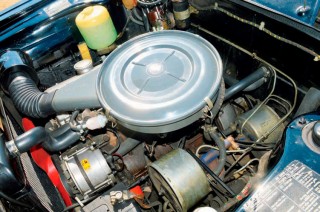
Vital to the success of the Neue Klasse programme was the need for a compact yet powerful 1.5-litre size engine. Called the M10 it would feature a five main bearing crankshaft and an overhead camshaft with the valves operated by rockers. Also critical was the cylinder block shape, which extended well down below the crankshaft centre line, thus creating a robust and stiff casting giving smooth running characteristics, especially at high revs. The only shortfall of the unit was its height, the answer being to install the engine at 30 degrees from the vertical plain. With bore and stroke measurements of 82x71mm the cubic capacity was 1499cc. Initial power was rated at 75hp. Later, the compression ratio was boosted increasing power to 80hp at 5700rpm. Carburation was a single Solex type while drive was taken through a single dry plate clutch linked to a four-speed gearbox.
Body construction utilised the latest unitary assembly process and styled by the talented Giovanni Michelotti based in Turin. The car relied on simple chrome trim for decoration while the established three-box silhouette encompassed the latest 1960s design trends with good glass/metal proportions allround producing elegance with simplicity. It set the tone for BMW’s styles for the future.
Underneath the front suspension was conventional MacPherson strut while on the rear wishbones were supported on coil springs, which were pivoted from a stout cross beam that also carried the differential housing. The wishbones were held firmly in place by semi-trailing arms, the arrangement giving firm roadholding at a time when many manufactures were still using semi-elliptic rear springs. The brakes were disc type up front and drums on the rear.
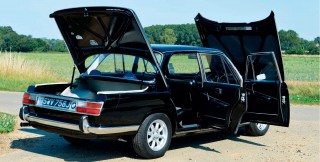
Called the BMW 1500, pre-production cars had been hurriedly finished to be exhibited at the Frankfurt Show in 1961 where response from the public was considerable, visitors having to queue up to gain a closer look at the exciting new model from Bayerische Motoren Werke. In the event, the 1960s would prove to be a busy period as orders for the Neue Klasse outstripped expectations and build capacity, and customers would have to wait until October the following year before cars began rolling off the line. Commercially it achieved all BMW’s hopes, establishing the company as a modern successful car maker of some repute now clearly moving towards financial stability and a strong future.
In late 1964 the 1500 model was replaced by a thoroughly reworked 1600 version. Making use of the Alex von Falkenhausen cylinder block design the engine received the first of its size hikes, this time to 1573cc. A second version, the 1773cc model, was badged as the 1800 and developed 90hp turning it into a full 100mph motorcar, followed soon after by the 110mph 1800Ti, which featured twin Solex carburettors while the motorsport team had cooked up an even faster track version, the 1800Ti/SA race car, which produced 130hp.
In January 1966 BMW launched the 2.0-litre Neue Klasse saloon, available with either a single or twin carburettor motor. The 1990cc unit was based on the 80mm stroke of the 1800 but with a larger 89mm bore. Called the 2000Ti, the two twin choke Solex carburettors on this engine produced a healthy 120hp at 5500rpm.
From the early successes in the 1950s with Isettas to the impressive results with the racing 700s in the early 1960s BMW’s reputation in motorsport circles grew exponentially with drivers like Hubert Hahne racing an 1800Ti; he won the German Championship in 1964. It is no surprise, therefore, that when The Autocar and Motor road-tested the Neue Klasse models, especially the quicker versions, they were at pains to point out their capabilities, the 1800Ti showing a maximum speed of 109mph with a 0-60mph time of 10.1 seconds.

But what about the two lovely examples we have in front of us today? They’re owned by father and son team, John and Paul Hill, with the white 1967 manual saloon belonging to Hill junior (Paul) while the black 1969 automatic is in Hill senior’s (John) custodianship. Quite often during our What’s in your Garage? features we learn how a son picked up his passion for a marque from his father, but in this instance it’s quite the reverse, as we’ll find out later. In the meantime Paul takes up the story of how the BMW bug bit: “When I left school one of my friends joined the army and was later posted out to Germany. When he returned he was driving this funny little square, orange, left-hand drive car at a time when all my friends and I owned Minis, Escorts, Cortinas and Vauxhalls. It was a round rear light BMW 2002 model of 1972/3 vintage. He suggested that I should take it up the road and the experience was mesmerising, the car seemed to fly even though it wasn’t even a fuel injection model. From that day on I was determined to have one. Then my friend went back to Germany, leaving the car at the rear of a friend’s flat. The next time I saw it, the BMW had been loaded onto the back of a trailer because thieves had totally stripped it.
“In 1990 another friend saw a BMW 2002 for sale in Suffolk and told me about it. It turned out to be a 1972 Touring. As I’d never seen one before I telephoned BMW specialist, Jaymic, near Norwich, to find out more about them. Convinced, I bought it. That was the beginning of my BMW career.
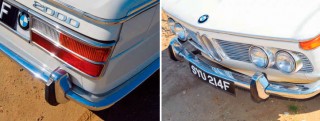
“I found my 1967 Neue Klasse advertised in Straight Six magazine in 2006. It is a 2.0-litre manual car, which I’d seen years before at Brooklands. It had been with the same owner since 1978 and restored between 2000 and 2003, though there was still a lot left to do when I bought it. Then, despite the engine having been rebuilt, it began smoking, so I rebuilt it along with the differential. It now performs perfectly.”
Paul and his father John are both passionate about their BMWs and we are in the lucky position of being able to try out both, a manual (Paul’s car) and John’s equivalent automatic version. First, let’s take Paul’s car for a spin. Climbing in to the large, light and pleasantly appointed interior immediately reveals the quality craftsmanship BMW afforded its top of the range saloons. According to Paul: “The first owner was Sir Michael Fergus Constable Maxwell Scott of Abbottsford. Initially, it was registered in Kuala Lumpur and it has a tropical pack, which includes a different specification thermostat, a larger radiator and a modification to the cooling fan.”
On the dashboard ahead are two simple dials, an easy to read speedo, and a second which includes fuel and temperature status, and ignition and high beam warning lights, all simply laid out. In the centre are the heater controls with a radio beneath. To the left is a generous glovebox. A large oddments container below, ahead of the gearshift, takes the usual paraphernalia accumulated while touring.
The ignition switch is located on the right-hand side of the steering column, surely one of the first of its type. A twist has the OHC straight-four spinning into life. The gearshift pattern is a conventional H arrangement. The clutch action is delightfully smooth though drive take up is almost at the end of its travel before it begins to bite, not an unusual characteristic, according to Paul.
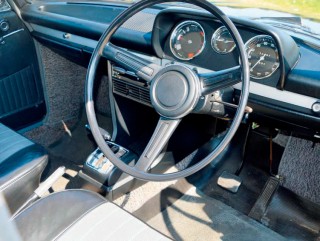
An all-important chapter in Paul’s saga of BMW ownership happened during the time when Jaymic ran a newsletter and advertised a 1975 1602 for sale in Norfolk. “By the time I telephoned the owner the advert was very out of date, yet he still had the car. I went up to see it and I bought it.” The deal provided Paul with a vital contact.
Up through the 2000’s ‘box and the gearshift proves to be delightfully light, if a little long in its travel. For a car from a performance manufacturer first and second gear ratios are set unusually low, with the change up points being around 20mph and 40mph (there’s no rev counter). Up to third, however, and the versatility of the power unit comes into its own with a 25-65mph range providing a wide spread of speed, ideal for overtaking. However, as Paul explains, to get the best performance out of the engine it has to be revved quite hard, a throwback to BMW’s sporting background.
With its single Solex PDSI downdraught carburettor the engine produces 100hp (DIN) at 5500 revs giving the car a 0-60mph acceleration time of 12.4 seconds and a top speed of 104mph – not bad for an over 22cwt saloon. Once in top gear the engine’s rewarding spread of power delivery becomes even more apparent providing the driver with 30-100mph capability. “It will sit on the motorway at 80-90mph,” says Paul with a grin.
The 16.9-inch wood-rimmed steering wheel gives good direction control and feedback from uneven surfaces is remarkably limited; only at manoeuvring speeds does the unassisted wheel need a tug. In the dead ahead position only slight correction is needed to keep the car on course.
The braking system is power-assisted on the 2000 models but, confusingly, using twin servos on right-hand-drive cars and a single unit on left-hand drive versions. It is thought that as this car was exported to the Far East it was given a single servo. Significantly, initial pressure appears to have limited effect until a firmer application of the brake pedal is applied bringing the car up all square.
As we continue the test Paul reveals more about his BMW history. “Over the years I’ve owned 13 1600s and 02s, two of which I still have, and a further seven Neue Klasse models, which includes the current manual and automatic models. My car has round headlights with an early Mk1 dashboard yet has a Mk2 rear end, bootlid and rear light cluster; almost a Mark-one-and-a-half.”
 In addition to the powertrain, the ride quality and handling qualities must be praised as clearly BMW hit a very impressive compromise with the Neue Klasse range between good road-holding characteristics and an impressively compliant suspension setup. There is no feeling of harshness nor of undue road roar making progress relaxed for all those in the car while the driver feels in full command of his surroundings. A truly a Jekyll and Hyde motorcar, the BMW responds to the driver’s every whim.
In addition to the powertrain, the ride quality and handling qualities must be praised as clearly BMW hit a very impressive compromise with the Neue Klasse range between good road-holding characteristics and an impressively compliant suspension setup. There is no feeling of harshness nor of undue road roar making progress relaxed for all those in the car while the driver feels in full command of his surroundings. A truly a Jekyll and Hyde motorcar, the BMW responds to the driver’s every whim.
As our first test comes to a close Paul explains the background to his father John’s passion for BMWs: “It was me who encouraged him. Up to the time when I left school he’d always owned Alfa Romeos, which he rallied, and I always remember being surrounded by various Alfa parts. Then his passion changed when I found the BMW marque sometime later.”
In 1997 the person Paul had bought the 1602 from passed on his details to a lady who had a rare 1969 BMW. “By then a widow, she telephoned me asking for advice as her husband, a warrant officer in the RAF, had traded-in an Austin A60 for it at a BMW dealership in Cyprus. My father and I went up to see the car, which turned out to be a beautiful black Neue Klasse 2000 automatic. We were there for most of the day. I suggested she should keep it and from then on she had it regularly serviced and MoT’d.”
Today, John’s 2000 automatic still looks in beautiful condition, the unusual gleaming Schwartz black coachwork suits the shape admirably. Walking round the car and one immediately spots the difference in the headlamps units: twins on the earlier manual model and large single headlamp pods on the later auto version, which combine sidelights, headlights and spot lamps under one lens.
Climbing inside it’s easy to notice subtle differences between the two models: the black steering wheel rim, for example, and behind the two large instruments have been joined by a clock mounted between the two larger dials. And to the left a useful recess has been added in the facia, above the glovebox.
John explains the background to how he and his son Paul came to buy the car: “In 2007 the lady who owned the Neue Klasse finally decided to sell it. We’d already valued the car for probate purposes and we were intent on paying her the market value.”
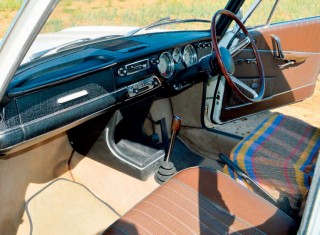
John’s car is fitted with a three-speed automatic gearbox. Slide the selector into drive, release the handbrake and take-up is smooth and relaxed. First gear is relatively low geared, the car moving up to second at around 20mph under normal throttle opening. This gives good reaction to the throttle, providing spirited acceleration when needed.
However, it is in top where the BMW 2000 Auto comes into its own, with reasonable pulling power from below 30mph up to 70mph and above, the car proves to be a relaxed high-speed car for touring. However, added pressure on the throttle has the auto ’box changing down and the car responding, giving a good turn of acceleration.
“With all the paperwork that came with the car we know that during the 1980s it had been fitted with a new cylinder head,” John continues. “However, since the purchase we’ve done very little to it other than servicing it and fitting the Minilite-type alloy wheels, which give the car a more sporting appearance.”
Like the manual version, with its independent suspension all-round, this version of the Neue Klasse range successfully combines the signature of a sporting car with the softness of ride quality of a luxury saloon, all adding up to make the 2000 Auto a satisfying vehicle to drive.
As with the manual model, the brakes and steering are well up to their job, giving the driver supreme confidence. Being an export model the servo assisted braking system is a novel split circuit arrangement, one servo actuating the rear drums and one cylinder on each of the front callipers while the second servo’d circuit operates on the other cylinder of the twin leading front brakes, the notion being that in the case of one circuit failing, there will still be some braking effect. In their test The Autocar said this system needed familiarisation. And so it seems, giving the driver confidence in the car.
“We take our cars to shows and events. This one won the concours event at Gaydon in 2014,” says John proudly. “We’ve also taken it to Classic Le Mans. Our longest journey was to Bavaria, through Holland, Belgium, Luxemburg and into Germany to visit the factory; the team there had never seen a black Neue Klasse before. It creates a great deal of attention wherever it goes. Overall, we cover around 1500 miles per year in it.”
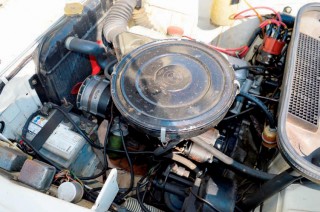
When new the price of the Neue Klasse models were clearly in a league of their own outstripping that of the Triumph 2.5PI and the Rover 2000 of the day by a marked margin. No wonder it was the beginning of BMW’s reputation as a maker of high profile cars. “For me the attraction of the Neue Klasse is that it feels and handles as though it was hand-made with its dials, fixtures and fittings,” concludes Paul as we stand admiring the two cars. “My ultimate dream is an 1800Ti… if I can find one. My car went to Le Mans in 2014 while my plan for the future is to respray it in its original Manila beige. I’ve been collecting bodywork and brightwork parts for some time. Next year I plan to take it to the south of France, so I’ll be fitting a fivespeed gearbox from an E21, which will make highspeed cruising more relaxed.”
“The attraction of the Neue Klasse is that it feels and handles as though it was hand-made with its dials, fixtures and fittings”
With reasonable pulling power from below 30mph up to 70mph and above, the car proves to be a relaxed high-speed car for touring.
To get the best out of the engine it has to be revved quite hard, a throwback to BMW’s sporting background.
THANKS TO Paul and John Hill for their considerable help with this article





